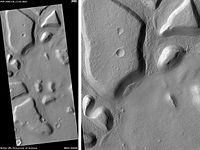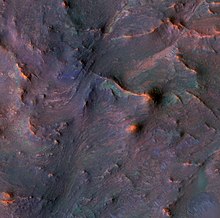尼羅瑟提斯桌山群
| 尼罗瑟提斯桌山群 | |
|---|---|
 阿斯塔普斯小丘群中的山冈和凸岩 | |
| 坐标 | 36°52′N 67°54′E / 36.87°N 67.9°E坐标:36°52′N 67°54′E / 36.87°N 67.9°E |


尼罗瑟提斯桌山群(Nilosyrtis Mensae)位于火星卡西乌斯区,其中心坐标为北纬36.87°、东经67.9°,它的东西经度分别为74.4°E和 51.1°E;南北纬度分别是 29.61°N和 36.87°N[2][2]。尼罗瑟提斯桌山群正对着西面的普罗敦尼勒斯桌山群,二者都坐落在火星分界线上。该桌山群纵横约705公里(438英里),取名自火星古典反照率特征,1973年被国际天文联合会正式接受。
尼罗瑟提斯桌山群的表面被归属为锐蚀地形(Fretted Terrain)。这里有悬崖、台地和宽阔平坦的山谷,其表面地貌被认为是由岩屑覆盖的冰川所造成[3][4]。这些围绕着丘群和桌山的冰川,被称为舌状岩屑坡[5][6][7][8];当冰川位于山谷中时,又被称为线状谷底沉积[9][10][11][12]。
气候变化导致的富冰特征[编辑]
几十年来,火星上的许多地貌特征,包括尼罗瑟提斯桌山群,都被认为含有大量的冰。这一想法被火星勘测轨道飞行器上的浅层雷达(SHARAD)所证实,勘测结果表明,舌状岩屑坡(LDA)和线状山谷沉积(LVF)都含有纯净水冰,上面覆盖着一层隔温的薄岩层 [13][14]。在北半球包括尼罗瑟提斯桌山群在内的许多地方都发现了冰[15]。
关于冰的起源,最流行的模型是火星自转轴倾角的巨幅变化所引起的气候改变,有时倾斜角甚至超过80度[16][17],巨大的倾斜变化解释了为何火星上有许多富含冰的特征。
研究表明,当火星的倾角从目前的25度倾斜到45度时,两极的冰就不再稳定[18],此外,在这一高倾角时,固体的二氧化碳(干冰)就会升华,从而增加了大气压力,这种增加的压力会使更多的尘埃保留在大气中,大气中的水分将以雪或冰的形式落在尘埃颗粒上,计算表明这种物质将集中在中纬度地区[19][20],火星大气环流模式预测,富冰尘埃将会堆积在已发现有富冰特征的同一区域[21]。 当火星倾斜角逐惭回归到较低值时,水冰将会升华(直接变成气体)[22][22][23]并留下一层尘埃,留下的沉积覆盖了底层物质。所以每次自转轴的大幅度摇摆循环,都会使一些富冰层留在下面[24]。注意,光滑的表面覆盖层可能只代表相对较新的物质。
另请参阅[编辑]
參考資料[编辑]
- ^ The Color Palette of Nilosyrtis Mensae (页面存档备份,存于互联网档案馆) at University of Arizona/HiRISE
- ^ "尼羅瑟提斯桌山群". Gazetteer of Planetary Nomenclature. USGS Astrogeology Research Program.
- ^ Greeley, R. and J. Guest. 1987. Geological map of the eastern equatorial region of Mars, scale 1:15,000,000. U. S. Geol. Ser. Misc. Invest. Map I-802-B, Reston, Virginia
- ^ Sharp, R. 1973. Mars Fretted and chaotic terrains. J. Geophys. Res.: 78. 4073-4083
- ^ Plaut, J. et al. 2008. Radar Evidence for Ice in Lobate Debris Aprons in the Mid-Northern Latitudes of Mars. Lunar and Planetary Science XXXIX. 2290.pdf
- ^ Carr, M. 2006. The Surface of Mars. Cambridge University Press. ISBN 978-0-521-87201-0
- ^ Squyres, S. 1978. Martian fretted terrain: Flow of erosional debrid. Icarus: 34. 600-613.
- ^ ISBN 0-8165-1257-4
- ^ Morgan, G. and J. Head III. 2009. Sinton crater, Mars: Evidence for impact into a plateau icefield and melting to produce valley networks at the Hesperian-Amazonian boundary. Icarus: 202. 39–59.
- ^ Morgan, G. et al. 2009. Lineated valley fill (LVF) and lobate debris aprons (LDA) in the Deuteronilus Mensae northern dichotomy boundary region, Mars: Constraints on the extent, age, and episodicity of Amazonian glacial events. Icarus: 202. 22–38.
- ^ Head, J., et al. 2006. Extensive valley glacier deposits in the northern mid-latitudes of Mars: Evidence for the late Amazonian obliquity-driven climate change. Earth Planet. Sci. Lett. 241. 663-671
- ^ Head, J., et al. 2006. Modification if the dichotomy boundary on Mars by Amazonian mid-latitude regional glaciation. Geophys. Res Lett. 33
- ^ Plaut, J. et al. 2008. Radar Evidence for Ice in Lobate Debris Aprons in the Mid-Northern Latitudes of Mars. Lunar and Planetary Science XXXIX. 2290.pdf
- ^ 存档副本. [2020-11-02]. (原始内容存档于2021-03-09).
- ^ Plaut, J., A. Safaeinili,, J. Holt, R. Phillips, J. Head, J., R. Seu, N. Putzig, A. Frigeri. 2009. Radar evidence for ice in lobate debris aprons in the midnorthern latitudes of Mars. Geophys. Res. Lett. 36. doi:10.1029/2008GL036379.
- ^ Touma J. and J. Wisdom. 1993. The Chaotic Obliquity of Mars. Science 259, 1294-1297.
- ^ Laskar, J., A. Correia, M. Gastineau, F. Joutel, B. Levrard, and P. Robutel. 2004. Long term evolution and chaotic diffusion of the insolation quantities of Mars. Icarus 170, 343-364.
- ^ Levy, J., J. Head, D. Marchant, D. Kowalewski. 2008. Identification of sublimation-type thermal contraction crack polygons at the proposed NASA Phoenix landing site: Implications for substrate properties and climate-driven morphological evolution. Geophys. Res. Lett. 35. doi:10.1029/2007GL032813.
- ^ Levy, J., J. Head, D. Marchant. 2009a. Thermal contraction crack polygons on Mars: Classification, distribution, and climate implications from HiRISE observations. J. Geophys. Res. 114. doi:10.1029/2008JE003273.
- ^ Hauber, E., D. Reiss, M. Ulrich, F. Preusker, F. Trauthan, M. Zanetti, H. Hiesinger, R. Jaumann, L. Johansson, A. Johnsson, S. Van Gaselt, M. Olvmo. 2011. Landscape evolution in Martian mid-latitude regions: insights from analogous periglacial landforms in Svalbard. In: Balme, M., A. Bargery, C. Gallagher, S. Guta (eds). Martian Geomorphology. Geological Society, London. Special Publications: 356. 111-131
- ^ Laskar, J., A. Correia, M. Gastineau, F. Joutel, B. Levrard, and P. Robutel. 2004. Long term evolution and chaotic diffusion of the insolation quantities of Mars. Icarus 170, 343-364.
- ^ 22.0 22.1 Mellon, M., B. Jakosky. 1995. The distribution and behavior of Martian ground ice during past and present epochs. J. Geophys. Res. 100, 11781–11799.
- ^ Schorghofer, N., 2007. Dynamics of ice ages on Mars. Nature 449, 192–194.
- ^ Madeleine, J., F. Forget, J. Head, B. Levrard, F. Montmessin. 2007. Exploring the northern mid-latitude glaciation with a general circulation model. In: Seventh International Conference on Mars. Abstract 3096.
| ||||||||||||||||||||||||||||||||||||||||||||||||||||||||||||||||||||||||||||||||||||||||
